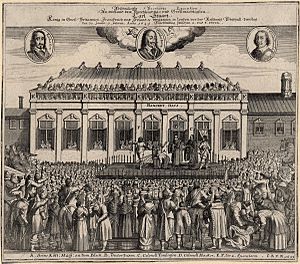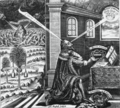William Levett (courtier) facts for kids
Quick facts for kids
William Levett, Esq.
|
|
|---|---|
| Born |
William Levett
Melton Mowbray, Leicestershire, England
|
| Occupation | courtier; land agent; magistrate |
| Employer | King Charles I of England, King Charles II of England |
| Known for | courtier who accompanied King Charles I on his flight from Cromwell forces to imprisonment on Isle of Wight and to the scaffold for his execution |
| Title | Groom of the Bedchamber, Page of the Backstairs |
| Children | Catherine Levett Dering; Dr. Henry Levett |
| Parent(s) | James Levett |

William Levett was a very loyal helper, or courtier, to King Charles I of England. He was with the King during a very difficult time in English history, when the King was fighting against Parliament's forces. Levett stayed by the King's side as he tried to escape, during his time as a prisoner, and even at the King's execution.
After the King died, Levett wrote a letter. In this letter, he said he saw King Charles writing a famous book called Eikon Basilike while he was in prison. This letter helped make people see the King as a hero who died for his country.
Contents
William Levett's Life and Loyalty
William Levett was probably born in Melton Mowbray, Leicestershire, England. He came from a family with a long history. He started working for the King as a Page of the Backstairs, which meant he was a personal attendant. He later became a Groom of the Bedchamber, an even more important role, helping the King directly in his private rooms.
Levett started working for King Charles I early in the King's rule. He became a page in the King's bedchamber in 1644. As the English Civil War continued, King Charles was captured and sent to Carisbrooke Castle on the Isle of Wight. The King trusted Levett so much that he asked for Levett to be one of the few people allowed to stay with him. Levett had already shown his bravery by helping the King escape from Hampton Court palace.
The Eikon Basilike Book
Later in his life, William Levett wrote a letter from his home in Wiltshire. In this letter, he said he had seen King Charles writing the Eikon Basilike. This book was very important because it was said to be the King's own thoughts and prayers while he was suffering.
Levett wrote: "If anyone has a desire to know the true author of the book entitled Eikon Basilike, I, one of the servants of King Charles the First, in his bedchamber, do declare, when his said Majesty was prisoner in the Isle of Wight, that I read over the above mentioned book, (which was long before the said book was printed) in his bed-chamber, writ with his Majesty's own hand, with several underlinings."
He also mentioned that the printer, Richard Royston, was put in prison by Oliver Cromwell (who led the Parliament's forces) for not saying that the King did not write the book. This shows how important the book was at the time. Levett gave this letter to his son, Dr. Henry Levett.
Another courtier, John Ashburnham, also wrote about Levett. He said that Levett was very close to the King and was often with him. This shows how much the King trusted William Levett.
The King's Final Moments
William Levett was with King Charles I until the very end. After the King was executed, Oliver Cromwell allowed the King's body to be prepared for burial. On February 7, 1649, William Levett and four other loyal helpers carried the King's body to St George's Chapel at Windsor Castle for a private burial.
Life After the King
After King Charles I's death and the rule of Oliver Cromwell, the monarchy was eventually brought back to England. This time is known as the Restoration. William Levett continued to serve the new King, King Charles II of England, as a Page of the Backstairs starting in 1660.
Levett spent the rest of his life in Wiltshire. He worked as an agent and surveyor for a noble family. He also tried to get a pension for his many years of loyal service to the Crown. He did receive some money from the King from time to time.
Two of William Levett's young children are buried at Holy Rood Church in Swindon. His daughter, Catherine Levett, married Rev. Edward Dering. She died in 1701 and is buried in a church in Kent. A monument there mentions her father's loyalty to King Charles I.
The sworn statement Levett made about the King's book, which was given to his son, later went missing. However, some special items given to Levett by King Charles after his death are still owned by Levett's family today. These items are kept at Milford Hall in Staffordshire. It is also believed that two portraits of King Charles I and his Queen, painted by Sir Anthony van Dyck, were first owned by William Levett.
Images for kids
-
The famous front page of the Eikon Basilike book. Later versions included William Levett's statement.



